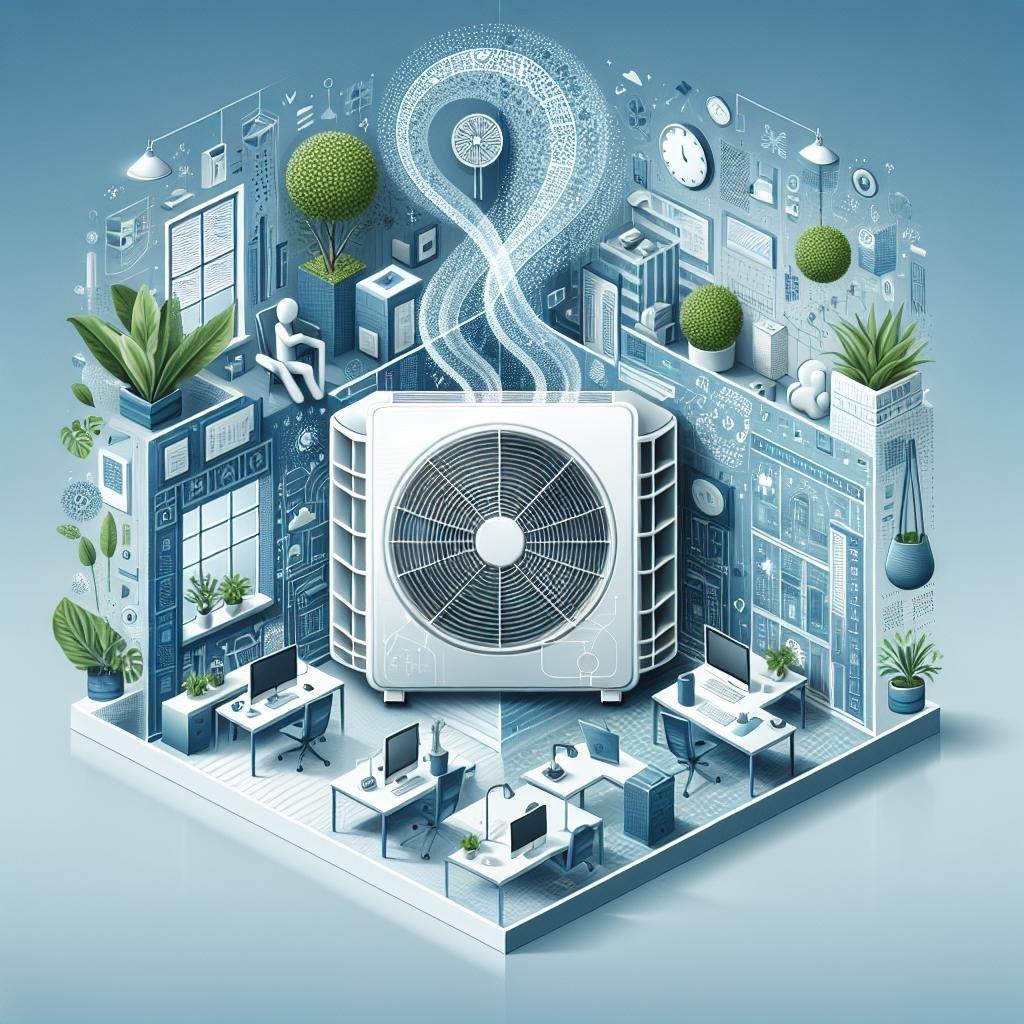In the modern work environment, where the hustle and bustle of daily tasks competes with the need for comfort and well-being, maintaining a healthy indoor atmosphere has never been more crucial. As office buildings and workspaces evolve to accommodate the demands of a diverse workforce, heating, ventilation, and air conditioning (HVAC) systems play a pivotal role in enhancing both productivity and health. Among these systems, mini split air conditioning units are carving out a niche as innovative solutions. Not only do they deliver efficient temperature control, but they also significantly improve indoor air quality—a critical factor that influences employee satisfaction and performance. In this article, we will explore how mini split AC systems can transform office environments by enhancing air quality, ensuring a fresher, more invigorating workspace conducive to creativity and collaboration.
benefits of Mini split AC Systems for Improved Air Circulation
Mini split AC systems excel in ensuring optimal air circulation throughout commercial spaces.Unlike customary HVAC systems that rely on bulky ductwork, these units provide targeted cooling and heating directly where it is needed most. The absence of ducts not only eliminates the possibility of dust and allergens accumulating within, but also significantly increases energy efficiency. With multiple indoor units connected to a single outdoor compressor, businesses can control temperatures in individual rooms or zones, creating a personalized comfort level for employees. This tailored approach helps promote productivity and enhances overall workplace morale.
Another advantage lies in the advanced filtration systems commonly integrated into mini split units. These filters trap airborne particles, such as dust, pollen, and pet dander, contributing to cleaner indoor air. Additionally, some models are equipped with ionizers that further purify the air, reducing the presence of pollutants and allergens. Consequently, offices can maintain a healthier environment that fosters creativity and reduces sick days.Implementing mini split AC systems in workspaces not only ensures efficient cooling but also plays a crucial role in promoting an overall healthier atmosphere for employees.
The Role of Air Filtration in Promoting Healthier Indoor Environments
Air filtration systems play a crucial role in maintaining the quality of indoor environments, especially in office buildings and workspaces where people spend a ample amount of time. By effectively capturing and eliminating harmful particles, including dust, allergens, and volatile organic compounds (VOCs), these systems contribute to a more pleasant and productive atmosphere. The integration of air purifiers with mini split AC systems ensures that clean, filtered air circulates throughout the space, promoting overall well-being. Key aspects of effective air filtration include:
- HEPA Filters: Highly efficient in trapping tiny particles.
- Activated Carbon: Absorbs odors and VOCs.
- MERV Ratings: Measures filter effectiveness; the higher, the better.
Furthermore, maintaining optimal indoor air quality can lead to significant improvements in employee health and productivity. Clean air can reduce sick days and improve focus, thereby addressing common issues such as fatigue and irritation caused by poor ventilation. With the help of modern mini split AC units, workplaces can effectively manage humidity levels, which also affects air quality. The following table outlines how a combination of air filtration and climate control features in mini split systems can enhance indoor environments:
| Feature | Benefit |
|---|---|
| Air Filtration | removes allergens and pollutants |
| Dehumidification | Prevents mold and mildew growth |
| Temperature Control | Enhances comfort for all employees |

Energy Efficiency and Its Impact on Overall Air Quality
Energy efficiency plays a crucial role in improving indoor air quality, particularly in office environments where people spend a significant portion of their day.By utilizing mini split air conditioning systems, businesses can optimize energy use while simultaneously enhancing air quality.These systems not only consume less energy compared to traditional HVAC units but also minimize the release of harmful pollutants and greenhouse gases.This reduction is essential, as poorer air quality can lead to a host of health issues, affecting productivity and well-being among employees. In essence, a more efficient system translates into fresher, cleaner air, promoting a healthier workspace.
Moreover, mini split systems are equipped with advanced filtration mechanisms that capture dirt, dust, and allergens circulating in the air.Implementing these technologies can definitely help maintain a lower level of indoor pollutants, creating a more cozy atmosphere. Consider the following benefits of enhancing air quality through energy-efficient systems:
- Reduced energy consumption leading to lower operational costs.
- Improved employee health resulting in fewer sick days.
- Enhanced productivity with a more comfortable working environment.
- Longer lifespan of HVAC equipment due to less strain on the system.

Practical Tips for Integrating Mini Split AC with Existing HVAC Systems
Integrating a mini split AC unit with your current HVAC system can significantly improve the overall comfort and air quality of office environments. Begin by assessing the layout of your workspace to identify areas that require supplemental cooling or heating. Strategically place mini splits in zones that the existing system struggles to maintain, such as conference rooms or dens crowded with employees. It’s also essential to consider the placement of the indoor units to avoid obstruction from furniture or partitions, ensuring optimal airflow throughout the space.
When incorporating mini splits, be mindful of refrigerant lines and electrical connections to avoid compatibility issues. Utilize a licensed technician to evaluate your current system and determine necessary modifications. To ensure seamless integration, opt for mini split units that offer smart controls, which can enhance functionality alongside your existing system. Regular maintenance is vital: schedule periodic checks to guarantee efficient operation, clean filters, and keep seawater components free of debris, ensuring that your integrated system delivers peak performance and quality air circulation consistently.
Q&A
Q: What is a mini split AC system and how does it work?
A: A mini split AC system is a type of air conditioning that comprises an outdoor compressor unit and one or more indoor air-handling units. It effectively works by utilizing refrigerant to absorb heat from the indoor air, which is then expelled outside, while simultaneously circulating cooled air back into the space. Its ductless design enables adaptability in installation and zone control for varying temperatures throughout different areas.
Q: How can mini split AC systems enhance indoor air quality in office buildings?
A: Mini split AC systems improve indoor air quality by filtering and circulating air in a way that traditional HVAC systems often cannot. Equipped with advanced filtration systems, they can trap dust, allergens, and pollutants, ensuring that the air flowing through the workspace is cleaner. This reduction in airborne contaminants contributes to a healthier work environment.
Q: What specific features of mini split AC systems contribute to better air quality?
A: Many mini split models come with features such as multi-stage filtration, which captures a variety of particles, and the ability to control humidity levels. Some even include antimicrobial filters that inhibit the growth of mold and bacteria. The independent operation of indoor units also allows for more targeted air control, minimizing the recirculation of stale air.
Q: Can mini splits help with humidity control, and why is this vital?
A: Yes, mini split AC systems are particularly effective at controlling humidity levels without overcooling the space.Proper humidity control is critical as it prevents the growth of mold and mildew, which can thrive in overly humid conditions. Maintaining optimal humidity levels (between 30-50%) not only enhances comfort but also plays a significant role in preventing respiratory issues among employees.
Q: Are there energy efficiency benefits associated with using mini split AC in offices?
A: Absolutely! Mini split AC systems are known for their high energy efficiency ratings. They consume less electricity compared to traditional systems, which can reduce energy consumption and lower utility bills for office buildings. By using less energy, they also contribute to a lower carbon footprint, aligning with modern sustainability goals.
Q: how does zoning with mini split AC systems work, and what are its advantages?
A: Zoning with mini split systems allows different areas of an office to be heated or cooled independently. Each indoor unit can be set to a different temperature based on individual preferences or specific workspace needs. This tailored approach not only enhances comfort but also optimizes energy use, as spaces that are not in use can be maintained at higher, less demanding energy levels.
Q: Could there be any downsides or considerations when installing mini split AC systems in an office?
A: While mini split AC systems offer numerous benefits, some considerations include the initial installation cost, which can be higher than that of traditional systems, and the need for professional installation. It’s important to ensure regular maintenance to maximize efficiency and longevity. the design and aesthetic of multiple indoor units should be considered to ensure they align with the office layout and décor.
Q: What should building managers consider when choosing a mini split AC system for their offices?
A: Building managers should evaluate factors such as the size of the workspace, the specific heating and cooling needs of employees, energy efficiency ratings, and available features like air purification or humidity control.Consultation with HVAC professionals can provide insights into the most suitable units based on building design, occupancy levels, and budget constraints.
Q: How can the implementation of mini split AC systems lead to improved employee productivity?
A: Improved indoor air quality and optimal thermal comfort directly contribute to enhanced employee productivity. By reducing allergens and maintaining a comfortable environment, mini splits help employees stay focused and reduce fatigue. this translates into higher job satisfaction and perhaps lower absenteeism, fostering a healthier and more engaged workforce.
to sum up
the integration of mini split AC systems into office buildings and workspaces transcends mere temperature regulation; it paves the way for a transformative approach to indoor air quality. By enabling precise control over airflow and humidity levels while minimizing the circulation of stale air and contaminants, these systems create a healthier and more productive work environment. As workplaces continue to evolve and prioritize employee well-being,investing in mini split technology emerges as a prudent choice. Embracing this innovation not only fosters a cleaner, more comfortable atmosphere but also contributes to the overall efficiency and satisfaction of the workforce. As we move forward, let us acknowledge the pivotal role that thoughtful climate control systems play in shaping the future of our workspaces—where comfort, health, and productivity unite harmoniously.

